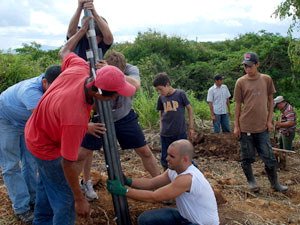Building turbines and relationships

When College of Science and Engineering student Scott Morton explains how the wind turbine his fellow students built in Minnesota is going to benefit a village in Nicaragua, you have to use your imagination.
After all, he’s telling the tale in a crowded café in Minneapolis where computers, smart phones, and all the amenities of urban American life are within easy reach.
The Nicaraguan village of La Hermita is a different story. There, residents “power” their humble homes with old car batteries and aren't quite as concerned about the relative merits of 3G vs. 4G speed.
"All they wanted was to be able to use the radio so they can get their news and know what's going on in the country."
That's why the 1-kilowatt wind turbine that the University of Minnesota student group Innovative Engineers delivered last summer and will activate soon is so important.
“The whole purpose of the wind turbine is to save [the La Hermita residents] from having to bring their old car batteries into the city to charge them,” said Morton, president of the year-old student group. “So with this turbine, people will not have to lose a whole day of work where they have to go into the city by horseback in the morning, charge their batteries, and then come back.
"All they wanted was to be able to use the radio so they can get their news and know what's going on in the country."
Coffee, "homebrew," and a mail-order guidebook
Innovative Engineers formed organically—and rather quickly—in 2009. Several students had taken part in a College of Science and Engineering Global Seminar on renewable energies in Scandinavia led by Paul Imbertson, who teaches in the Department of Electrical and Computer Engineering.
Just prior to that, while up late studying for finals, civil engineering student and seminar participant Alejandro De la Mora found himself online searching for related materials.
He ordered the book “Homebrew Wind Power” and brought it on the trip. On their return, some of the students began building a turbine in the basement of Imbertson’s home. In December 2009 De la Mora and Josh Durand cofounded the new student group, whose mission is to “partner with underdeveloped communities to meet their infrastructure needs for electricity and water according to locally available resources.”
Traveling turbine
Last summer a group of U students brought the wind turbine to La Hermita and installed the tower foundation. They also began collaborating with a local technical school and taught classes on renewable energy and wind power.
“We’re teaching them how [the turbine] works so if it fails or breaks, they are able to fix it,” says De la Mora, who graduated in December. (The wind turbine will become operational after some further testing.)
“These people are very interested in this technology,” adds Morton. “They see the possibility of what technology can do for people living outside of the cities.”
"They see the possibility of what technology can do for people living outside of the cities."
The education goes both ways.
“People may think, ‘Oh, that’s so nice that they’re going down and helping them,’” Morton says. “But I honestly think that going down there helped us more.”
De la Mora points out that the common refrain from La Hermita residents is, “I just need a light bulb and to be able to listen to the radio.”
“They are happy with so little and we want so much,” he adds. “This experience helps you realize what really is important in life.”
Exploding growth
In the past year, Innovative Engineers has grown to 85 members, spanning all the University of Minnesota's engineering disciplines and then some.
Accordingly, the group has added many more activities, including a hydro project at another location in Nicaragua and a fledgling wave energy project on campus. Members have built two additional 1-kilowatt wind turbines, too—one with the help of area middle school students through a program with the Science Museum of Minnesota.
And De la Mora, Imbertson, and a group of students just returned from Mexico, where they established a new chapter of Innovative Engineers at Universidad Ibero Americana in Mexico City.
Ultimately, Morton hopes that the group’s legacy will be lasting relationships with communities like La Hermita.
“We don’t go in there and set up something and say, ‘There you go,’ he said. “For each generation of new engineers [at the U], we’re hoping that they will go down there and see the same people and continue that relationship.”
